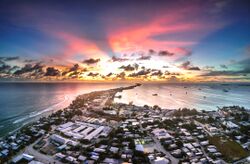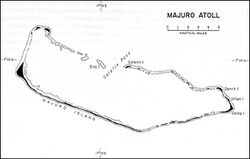Place:Delap-Uliga-Djarrit
Delap-Uliga-Djarrit Teļap-Wūlika-Jarōj | |
|---|---|
Urban area | |
 Marshall Islands capitol building in Delap-Uliga-Djarrit | |
| Country | Marshall Islands |
| Atoll | Majuro |
| Population (2011 census) | |
| • Total | 20,301 |
| Time zone | UTC+12 |
Delap-Uliga-Djarrit (DUD,[1] Template:Lang-mh) is an urban area in Majuro, the capital and the largest city of the Marshall Islands, with 15,846 people out of Majuro's 23,676 (as of 1999).[2] It consists of the districts of Delap, Uliga, and Djarrit (islets connected by land reclamation).[3] DUD is located on the eastern end of Majuro Atoll.[4] Marshallese government buildings are situated in DUD.[1]
Geography
Delap-Uliga-Djarrit is a densely populated urban area on the eastern end of Majuro Atoll. DUD is located on the three islets of Delap, Uliga, and Djarrit (from south to north).[2] Causeways connecting the islands were constructed in 1944.[5] The increasing population has led to extensive land reclamation on both the lagoon and the exterior coasts, with Delap and Uliga seeing the largest increase in land area (over 10%).[2]
History
Traditionally the center of Majuro Atoll was an islet now called Laura, which has been inhabited for over 2,000 years.[6] Majuro Atoll, along with the rest of the Marshall Islands, became part of the German Empire in 1885, and afterwards the Jaluit Trading Company established a trading outpost.[6] As with the rest of the Marshalls, Majuro was captured by the Imperial Japanese Navy in 1914 during World War I[6] and mandated to the Empire of Japan by the League of Nations in 1920. The island then became a part of the Japanese mandated territory of the South Seas Mandate; although the Japanese had established a government in the mandate, local affairs were mostly left in the hands of traditional local leaders until the start of World War II.[citation needed] In 1940, Japan built a seaplane base in the leeward part of the east of the atoll, located primarily on Djarrit. This choice of location was motivated by the lagoon being suitable for large ships, and the presence of patch reefs in the west, which made seaplane activities dangerous. The base was abandoned in late 1942.[6][7]
United States troops landed on the atoll on January 31, 1944 and promptly began building the major Naval Base Majuro, finished later that year.[5][8][7] American forces set up and improved infrastructure, including a runway covering much of Delap (Majuro Airfield), and military headquarters at Uliga and Djarrit.[6][5] Indigenous inhabitants of the area were forcibly relocated to the Majuro islet of Laura. By 1947 only a small administrative unit had remained, with the military having rapidly demobilized in 1945. The American administration made Majuro replace Jaluit as the capital of the Marshall Islands, due to the devastation of Jaluit during the war, and the presence of a US base on Majuro. In 1947, the Marshallese began returning to Delap and Djarrit, and the Delap runway began to be used for civil aviation. Rapid housing development took place in Delap-Uliga-Djarrit, which became the commercial and administrative center of the atoll. The population rapidly increased due to birth rates and internal migration. In 1970, the international airport was shifted west to the newly-built Amata Kabua International Airport to enable the expansion of Delap.[7][6][9] In 1986, the Marshall Islands became independent and Majuro became the national capital.[6]
Demographics
As of early 1944, about 400 people lived in small villages in Delap and Djarrit, while Uliga was not reported as being inhabited.[9] Delap-Uliga-Djarrit was very sparsely populated in 1947,[6] but it now has one of the highest population densities out of urban areas in the Pacific Islands.[3] DUD's population increased from 2,387 people in 1958, to 5,829 in 1970, to 8,003 in 1973.[9] In 1988, around 11,200 people lived in an area smaller than 1.5 km2 (0.6 sq mi) in DUD, while Djarrit had a population density of 17,537 people per km2.[10][7] As of 1999, the population of DUD was 15,846 people out of Majuro's 23,676; DUD had a population density of 8506 people per km2.[2][11] DUD's population was 20,301 on 1.32 km2 (0.5 sq mi) as of the 2011 census.[6]
Economy
Delap-Uliga-Djarrit contains Majuro's port, as well as shops, banks, restaurants, and hotels.[4]
In the early 1970s, "almost all" of the annual budget of Delap-Uliga-Djarrit was reported to come from alcohol taxes and fees, as only DUD, Laura, and Kwajalein Atoll in the Marshall Islands were "wet", i.e. alcohol sales were allowed.[12]
Points of interest
Alele Museum is located in Delap-Uliga-Djarrit. The Cathedral of the Assumption of the Roman Catholic Apostolic Prefecture of the Marshall Islands[13] and Baet-Ul-Ahad Mosque are located in town center.
Health
Education
Located in Delap-Uliga-Djarrit are the College of the Marshall Islands, Assumption High School, and Uliga Elementary School.[14] English is taught to all students.[citation needed]
The Marshall Islands High School is near the north end of the town.
The University of South Pacific has a presence on Delap-Uliga-Djarrit.[15]
Delap-Uliga-Djarrit has the Seventh Day Adventist High School and Elementary School where English is taught to all students.[16]
References
- ↑ 1.0 1.1 "Marshall Islands - Map, Flag, History, & Facts". https://www.britannica.com/place/Marshall-Islands.
- ↑ 2.0 2.1 2.2 2.3 Ford, Murray (January 2012). "Shoreline Changes on an Urban Atoll in the Central Pacific Ocean: Majuro Atoll, Marshall Islands". Journal of Coastal Research 279: 11–22. doi:10.2112/JCOASTRES-D-11-00008.1. https://www.researchgate.net/publication/261965972. Retrieved 29 August 2023.
- ↑ 3.0 3.1 Terry, James P.; Thaman, Randolph R. (2008). "Physical Geography of Majuro Atoll and the Marshall Islands". in Terry, James P.; Thomas, Frank R.. The Marshall Islands: Environment, History and Society in the Atolls. Suva, Fiji: The University of the South Pacific, Faculty of Islands and Oceans. p. 4. ISBN 978-982-01-0823-3. https://www.researchgate.net/publication/266518009. Retrieved 31 August 2023.
- ↑ 4.0 4.1 Skin Diver 1990-03: Vol 39 Iss 3. Petersen Publishing Company. March 1990. p. 129. https://archive.org/details/sim_skin-diver_1990-03_39_3/page/128/mode/2up?q=Delap+Uliga. Retrieved 10 September 2023.
- ↑ 5.0 5.1 5.2 "Marshall Islands -- Building the Navy's Bases -- Majuro Naval Base". https://marshall.csu.edu.au/Marshalls/html/WWII/Majuro_Base.html.
- ↑ 6.0 6.1 6.2 6.3 6.4 6.5 6.6 6.7 6.8 Weber, Eberhard; Koto, Camari (16 August 2021). "Disturbing the Creation of a Spatial System: Outside Intervention and Urbanization in the Republic of the Marshall Islands". The Routledge Handbook of Small Towns. Routledge. pp. 387, 398. ISBN 978-1-000-42163-7. https://books.google.com/books?id=Ek81EAAAQBAJ. Retrieved 10 September 2023.
- ↑ 7.0 7.1 7.2 7.3 Spennemann, Dirk H. R. (1 May 1996). "Nontraditional settlement patterns and typhoon hazard on contemporary Majuro atoll, Republic of the Marshall Islands". Environmental Management 20 (3): 337–348. doi:10.1007/BF01203842. ISSN 1432-1009. https://www.researchgate.net/publication/14538480. Retrieved 13 September 2023.
- ↑ Majuro Atollpacificwrecks.com
- ↑ 9.0 9.1 9.2 Sabath, Michael D. (October 1977). "Vegetation and Urbanization on Majuro Atoll, Marshall Islands". Pacific Science 31 (4): 325–326, 331. ISSN 0030-8870. https://core.ac.uk/download/pdf/5094141.pdf. Retrieved 10 September 2023.
- ↑ McMurray, Christine (2001). Diseases of globalization: socioeconomic transitions and health. London ; Sterling, VA : Earthscan Publications. p. 129. ISBN 978-1-85383-710-4. https://archive.org/details/diseasesofglobal0000mcmu/page/128/mode/2up?q=Delap+Uliga. Retrieved 10 September 2023.
- ↑ Ford, Murray; Merrifield, Mark A.; Becker, Janet M. (1 April 2018). "Inundation of a low-lying urban atoll island: Majuro, Marshall Islands". Natural Hazards 91 (3): 1273–1297. doi:10.1007/s11069-018-3183-5. ISSN 1573-0840. https://link.springer.com/article/10.1007/s11069-018-3183-5. Retrieved 31 August 2023.
- ↑ Marshall, Mac (1990). Silent voices speak : women and prohibition in Truk. Belmont, Calif. : Wadsworth Pub. Co.. pp. 35, 126. ISBN 978-0-534-12384-0. https://archive.org/details/silentvoicesspea0000mars/page/34/mode/2up?q=Delap+Uliga. Retrieved 10 September 2023.
- ↑ "Cathedral of the Assumption". GCatholic.org. http://www.gcatholic.org/churches/oceania/1549.htm. Retrieved 2013-01-15.
- ↑ Hess, Don; Hwang, Dennis J.; Fellenius, Karl; Robertson, Ian; Stege, Mark; Chutaro, Ben (2015). Homeowner's Handbook to Prepare for Natural Hazards: Republic of the Marshall Islands. https://repository.library.noaa.gov/view/noaa/36094/noaa_36094_DS1.pdf. Retrieved 31 August 2023.
- ↑ "Marshall Islands". Office of Electronic Information, Bureau of Public Affairs. https://2009-2017.state.gov/r/pa/ei/bgn/26551.htm. Retrieved 26 November 2011.
- ↑ SSD
Cite error: <ref> tag with name "Aus-O" defined in <references> is not used in prior text.
<ref> tag with name ":1" defined in <references> is not used in prior text.[ ⚑ ] 7°07′00″N 171°22′00″E / 7.1167°N 171.3667°E
 |






